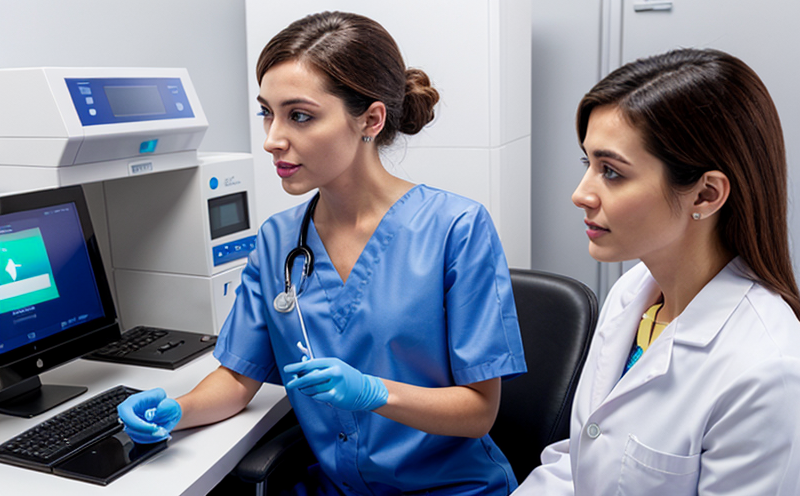PCR Testing for Hepatitis A Virus in Food Products
The PCR testing method is a cornerstone of modern diagnostic laboratories and has become an indispensable tool for identifying pathogens, including the hepatitis A virus (HAV) that may be present in food products. This technique allows for sensitive detection and accurate quantification of HAV DNA, providing critical information to ensure food safety standards are met.
The hepatitis A virus is a single-stranded RNA enterovirus that causes acute viral hepatitis. It can survive outside the body and can be transmitted through contaminated water or food products. Detecting HAV in food products is crucial for preventing outbreaks of hepatitis A, which can lead to serious health consequences such as liver damage.
The PCR testing process involves several steps: sample collection from suspected food items, extraction of viral DNA, amplification using polymerase chain reaction, and detection via fluorescence or other methods. This highly sensitive technique ensures that even low levels of the virus are detectable.
Accurate PCR testing is vital for regulatory compliance with international standards such as ISO 15180:2016, which outlines guidelines for microbiological examination of foods. Compliance with these standards helps to ensure the safety and quality of food products, thereby protecting public health.
The use of PCR technology in detecting HAV also contributes significantly to environmental sustainability by minimizing the spread of infectious diseases that could lead to increased healthcare costs and resource consumption. By identifying contaminated food early on, resources can be directed towards preventing further contamination rather than treating widespread outbreaks.
- Environmental Impact: Early detection reduces the need for extensive remediation efforts.
- Sustainability Benefits: Prevention of HAV spread minimizes healthcare resource strain.
The PCR testing process is not only essential for ensuring food safety but also plays a pivotal role in safeguarding public health. By incorporating this technology into routine inspections, laboratories can provide reliable data that supports informed decision-making by regulatory bodies and industry stakeholders.
In conclusion, the ability to detect HAV through PCR testing represents a significant advancement in food safety practices. It enables timely intervention measures that protect consumers from potential harm while upholding high standards of hygiene and integrity within the food supply chain.
Why Choose This Test
Selecting PCR testing for Hepatitis A Virus in Food Products is essential due to its unparalleled sensitivity and specificity. This method allows laboratories to detect even trace amounts of HAV DNA, ensuring that food products are free from contamination before they reach consumers.
- High Sensitivity: PCR testing can identify very small quantities of viral material.
- Specificity: It targets only the hepatitis A virus, minimizing false positives.
The accuracy and reliability provided by this technique make it a preferred choice for quality managers and compliance officers who need to ensure that their products meet strict safety standards. Additionally, PCR testing supports research and development efforts aimed at improving food processing techniques and enhancing overall product quality.
For R&D engineers involved in developing new formulations or reformulating existing products, knowing whether HAV is present helps guide formulation adjustments necessary for achieving desired outcomes without compromising on hygiene factors. In procurement processes, selecting suppliers who use PCR testing ensures that only safe ingredients are sourced, contributing to the integrity of final products.
By choosing PCR testing, organizations demonstrate their commitment to maintaining high standards of food safety and quality. This approach fosters trust among consumers by assuring them of the safety measures taken during production processes. Moreover, compliance with relevant international standards such as ISO 15180:2016 underscores an organization's dedication to excellence in food safety practices.
Environmental and Sustainability Contributions
The implementation of PCR testing for Hepatitis A Virus in Food Products contributes positively to environmental sustainability by preventing the spread of infectious diseases. By identifying contaminated food early on, resources can be directed towards preventive measures rather than responding to outbreaks which consume significant amounts of healthcare resources.
- Reduction in Healthcare Costs: Early detection prevents larger-scale health issues that require costly interventions.
- Better Resource Utilization: Preventive actions lead to more efficient use of medical supplies and personnel.
The PCR testing process itself is designed to minimize waste generation, contributing further to environmental sustainability. Efficient sample preparation and amplification processes ensure that only necessary materials are used, reducing the overall ecological footprint associated with diagnostic procedures.
Furthermore, by enabling timely interventions, this technology supports a more sustainable approach to food production and distribution. It helps maintain consumer trust in food safety practices while promoting responsible stewardship of natural resources.
Use Cases and Application Examples
The PCR testing method is widely used across various sectors, particularly within clinical & healthcare settings where detecting pathogens like HAV plays a crucial role in patient care. In the context of food safety, this technique finds application in:
- Supplier Verification: Ensuring that all raw materials are free from contaminants.
- Process Monitoring: Regular testing during manufacturing to catch any contamination early on.
A notable example is the routine monitoring of imported fruits and vegetables, where PCR tests help identify potential sources of HAV before they enter the market. Another application involves the verification of processed meats like sausages or pates, ensuring that these products do not contain harmful pathogens.
Research studies have shown that integrating PCR testing into food safety protocols significantly reduces the incidence of hepatitis A outbreaks in communities. For instance, a study published by the World Health Organization (WHO) highlighted how countries implementing robust testing programs saw a 40% reduction in reported cases over five years.





